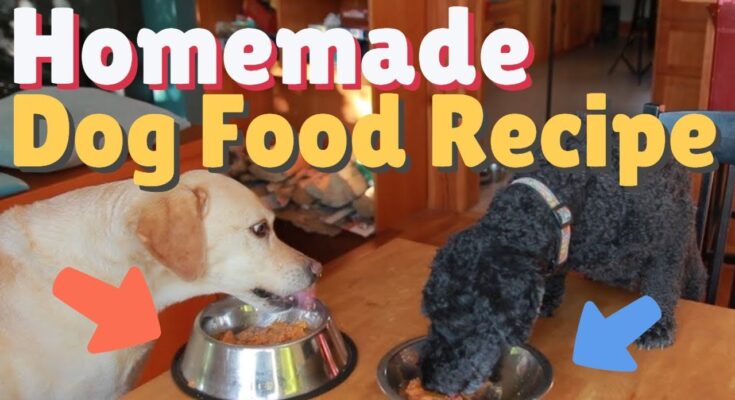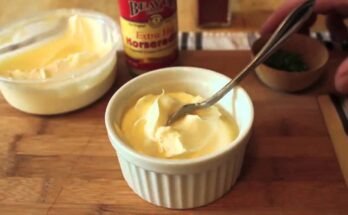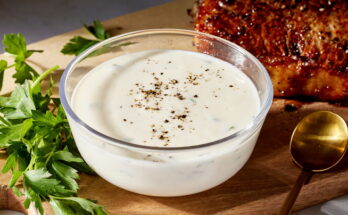Home Made Dog Food Recipe: Making dog food at home sounds intimidating at first, but trust me, once you get the hang of it, it’s super rewarding. Not only will you save money, but you’ll also have full control over what your furry friend is eating. In this guide, we’ll break down everything you need to know, from the reasons behind making dog food yourself to a complete, easy-to-follow recipe you can whip up in your own kitchen.
Why Choose Homemade Dog Food?
When it comes to feeding your dog, the options are endless. Shelves are packed with colorful bags of kibble and cans of wet food. But have you ever wondered what’s really inside? More importantly, is it what your dog should be eating?
Making your dog’s food at home allows you to tailor meals to their specific needs. Whether your pooch has allergies, a sensitive stomach, or you simply want them to have the freshest meals possible, homemade food can be a game changer.
Let’s be real—dogs are part of the family. We wouldn’t feed our kids junk every day, so why would we do that to our pups? Taking the time to prepare meals shows them love in one of the best ways possible.
Benefits of Homemade Dog Food
There’s a lot to love about preparing your dog’s meals:
- Quality Control: You know exactly what’s going into each bite—no mysterious “meat by-products” or unpronounceable preservatives.
- Customization: You can easily adjust recipes for your dog’s age, weight, activity level, and health issues.
- Freshness: Homemade meals are free from the long shelf life additives that processed foods need.
- Improved Health: Many pet owners report shinier coats, better digestion, increased energy, and even fewer vet visits after switching to homemade diets.
- Stronger Bond: Dogs know when you’re cooking for them. Expect some extra tail wags and puppy kisses!
However, it’s not all sunshine and rainbows. It requires a bit more effort and planning, but trust me, the rewards far outweigh the work.
Potential Risks and How to Avoid Them
While making homemade dog food is great, it’s crucial to do it right. A poorly balanced diet can lead to serious health issues like obesity, nutrient deficiencies, or organ damage.
Here’s how to avoid common mistakes:
- Consult Your Vet: Always talk to your vet or a canine nutritionist before switching to a homemade diet.
- Use Trusted Recipes: Random internet recipes might not provide complete nutrition.
- Supplement Wisely: Sometimes, your dog might need supplements to meet all their dietary requirements.
- Don’t Wing It: Guessing ingredients and proportions can hurt your dog’s health over time. Stick to well-balanced recipes!
Essential Nutrients Your Dog Needs
Dogs, just like humans, need a variety of nutrients to stay healthy. It’s not enough to just throw together some meat and rice; you need a good balance of proteins, carbs, fats, vitamins, and minerals.
Let’s break it down simply:
Proteins
Protein is the building block of your dog’s body. It’s crucial for maintaining muscles, repairing tissue, and supporting a healthy immune system. Good protein sources include:
- Chicken
- Beef
- Turkey
- Fish
- Eggs
Aim for high-quality proteins and vary them to prevent allergies and food sensitivities.
Carbohydrates
Carbs provide energy, fiber, and essential nutrients. Unlike what some myths say, dogs can digest carbs well, especially cooked ones. Great carb sources include:
- Brown rice
- Oats
- Sweet potatoes
- Quinoa
Carbs also keep your pup full and satisfied, which can help with weight control.
Fats
Fat is a crucial energy source and helps keep your dog’s coat shiny and skin healthy. But too much can lead to obesity, so balance is key. Healthy fat sources include:
- Fish oil
- Chicken fat
- Flaxseed oil
Always opt for natural fats and steer clear of anything deep-fried or overly processed.
Vitamins and Minerals
Dogs need a mix of vitamins and minerals to support everything from bone health to nerve function. Important ones include:
- Calcium (for strong bones)
- Zinc (for skin health)
- Vitamin A (for vision)
- B Vitamins (for metabolism)
Sometimes it’s hard to get everything from food alone, which is where supplements come in handy.
Ingredients to Use and Avoid
When making homemade dog food, your shopping list is just as important as the recipe itself. Knowing what’s safe—and what’s not—can mean the difference between a healthy meal and a dangerous one.
Safe and Healthy Ingredients
Here’s what you can safely add to your dog’s meals:
- Proteins: Chicken, turkey, beef, lamb, fish, eggs
- Vegetables: Carrots, green beans, peas, spinach, zucchini
- Grains: Brown rice, oats, quinoa
- Fruits: Blueberries, apples (without seeds), bananas
- Fats: Olive oil, flaxseed oil, fish oil
These ingredients are packed with essential nutrients and are easy on your dog’s digestion.
Dangerous Foods for Dogs
Just because it’s healthy for humans doesn’t mean it’s safe for dogs. Here’s a quick list of no-nos:
- Chocolate
- Onions and garlic
- Grapes and raisins
- Avocado
- Macadamia nuts
- Xylitol (a sugar substitute often found in peanut butter)
Even small amounts of these can cause serious health problems, so always double-check ingredients before tossing them into the bowl.
Basic Equipment You’ll Need
Before you dive into cooking, make sure you’ve got the right tools ready. No fancy gadgets are needed, but a few basics will make life a lot easier.
Must-Have Kitchen Tools for Making Dog Food
- Large Stockpot: For boiling meat and grains.
- Sharp Knife and Cutting Board: Essential for prepping ingredients.
- Mixing Bowls: To combine everything evenly.
- Measuring Cups and Spoons: Precision is key for balanced nutrition.
- Storage Containers: Airtight containers help keep food fresh.
- Blender or Food Processor (Optional): Helpful for pureeing vegetables for smaller dogs or picky eaters.
Having these tools ready will save you time and help you maintain cleanliness and food safety standards.
Step-by-Step Homemade Dog Food Recipe
Alright, now let’s get to the exciting part—actually cooking a nutritious, tail-wagging meal for your best buddy! Don’t worry if you’re not a master chef; this recipe is simple, straightforward, and super flexible depending on your dog’s taste and dietary needs.
Ingredients List
Here’s what you’ll need for a basic, balanced batch of homemade dog food:
- 2½ pounds of ground turkey or chicken
- 1½ cups brown rice
- 1 cup chopped spinach
- 1 cup shredded carrots
- 1 cup green peas
- 1 tablespoon olive oil
- 4 cups water or low-sodium chicken broth
Feel free to swap out proteins (like using beef or fish) and veggies based on what’s available and what your dog prefers.
Step 1: Preparing the Ingredients
First thing’s first, gather all your ingredients and tools. Wash all vegetables thoroughly to remove any pesticides or dirt. Peel and chop the carrots, rinse the spinach, and measure out your rice and water.
Preparation is key here—just like cooking for humans, a little time spent upfront makes the whole process smoother. Plus, your dog is probably already sniffing around excitedly, so the quicker you get started, the better!
Step 2: Cooking the Meat and Grains
Heat a large stockpot over medium heat and add the olive oil. Once it’s warm, toss in your ground turkey or chicken. Cook it thoroughly, breaking it up with a spoon until it’s browned and no longer pink. This step is important—raw meat can be risky for dogs if not handled properly.
Once the meat is cooked, add the brown rice and water or broth. Bring it to a boil, then reduce the heat and let it simmer for about 20 minutes. This will allow the rice to cook and soak up all those tasty meat juices.
During this time, you’ll notice the delicious smell filling your kitchen—your dog definitely will too!
Step 3: Mixing Everything Together
After the rice is cooked and fluffy, it’s time to toss in the veggies. Add the carrots, spinach, and peas into the pot. Stir everything together and cook for another 5 minutes, just enough to soften the veggies but not so much that they lose their nutrients.
You want the final mix to look colorful and hearty—kind of like a super healthy casserole.
Once everything is combined and cooked, remove the pot from heat and let the food cool to room temperature. Dogs can be impatient eaters, but hot food can burn their mouths!
Step 4: Proper Storage Tips
After the food cools, portion it out into meal-sized servings. Store these in airtight containers or resealable freezer bags.
- In the fridge: Homemade dog food will stay fresh for about 3-5 days.
- In the freezer: You can store extra portions for up to 3 months.
Always label your containers with the date you made the food so you know when it’s time to toss it. When serving from the fridge or freezer, you can warm it up slightly to bring out the aromas (just make sure it’s not hot).
Tips for Feeding Homemade Dog Food
Making the food is just half the battle—you also want to make sure you’re serving it properly!
Serving Sizes
How much homemade food should you give your dog? It depends on factors like their weight, age, and activity level. A general guideline is:
- Small dogs (under 20 pounds): ½ – 1 cup per meal
- Medium dogs (20-50 pounds): 1 – 2 cups per meal
- Large dogs (50+ pounds): 2½ – 4 cups per meal
Split their daily portion into two meals—morning and evening—for best digestion and energy levels.
Always monitor your dog’s weight and energy. If they start gaining a little too much weight, scale back slightly. If they seem hungrier or lose weight, bump it up a bit.
Transitioning from Store-Bought to Homemade
Switching your dog’s diet cold turkey (pun intended!) can cause stomach upset. To avoid this, transition gradually:
- Day 1-2: 75% old food, 25% homemade
- Day 3-4: 50% old food, 50% homemade
- Day 5-6: 25% old food, 75% homemade
- Day 7: 100% homemade
Every dog is different, so watch for signs like diarrhea, vomiting, or a lack of appetite. If that happens, slow down the transition and give their system more time to adjust.
FAQs about Homemade Dog Food Recipe
Is homemade dog food better for my dog?
Homemade dog food can be better if it’s properly balanced with the right nutrients. It allows you to control the ingredients and avoid fillers or preservatives found in some commercial dog foods.
What ingredients should I avoid in homemade dog food?
Avoid onions, garlic, chocolate, grapes, raisins, avocados, and foods high in fat, salt, or sugar. These can be toxic or harmful to dogs.
Can I feed my dog homemade food every day?
Yes, you can feed homemade meals daily, but it’s crucial to ensure the food meets your dog’s nutritional needs. Consulting a vet or a pet nutritionist is highly recommended.
How can I make sure homemade dog food is nutritionally complete?
Use a vet-approved recipe or add a canine multivitamin supplement. Balancing proteins, carbs, healthy fats, and essential vitamins is key for your dog’s health.
What proteins are best for homemade dog food?
Lean meats like chicken, turkey, beef, and fish are excellent protein sources. Always cook the meat properly and remove any bones.
Can I freeze homemade dog food?
Absolutely! Homemade dog food freezes well and can be stored for up to 2–3 months. Just portion it out before freezing for easy serving.
How much homemade food should I feed my dog?
Portion sizes depend on your dog’s size, age, activity level, and specific dietary needs. A vet can help you determine the right amount.
Conclusion
There’s something truly special about preparing homemade meals for your dog. Not only do you have full control over the ingredients and nutrition, but you also deepen the bond between you and your furry best friend. With a little planning and love, you can make sure your dog lives a healthier, happier life—one delicious bowl at a time.
Remember, always consult your vet before making major changes to your dog’s diet. Every dog is unique, and what works for one may not work for another. But with the basics you’ve learned here, you’re well on your way to being the best dog parent ever!



